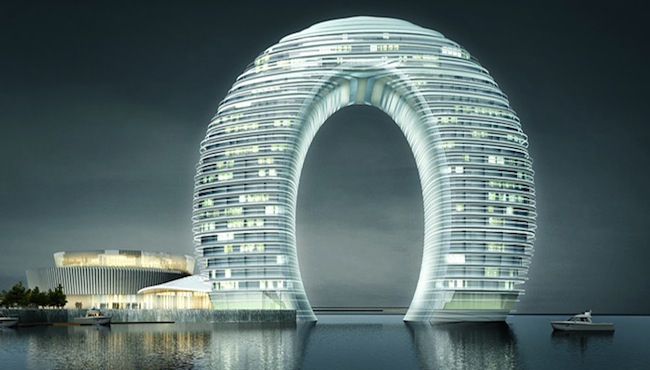The Emporis Skyscraper Award, the world's most renowned prize for skyscrapers, this year goes to London.
The tallest building in Western Europe, The Shard, was chosen by an international panel of experts from more than 300 skyscrapers of at least 100 meters' height and which were completed during the previous calendar year.
The award, given by Emporis, the international provider of building data, is now into its 14th year.
The 306-meter-tall winning building, designed by the architect Renzo Piano, won over the jury thanks to its unique glass fragment-shaped form and its sophisticated architectural implementation.
"Construction of The Shard was complicated by the particularly tight site and therefore needed innovative planning. This makes the result all the more impressive: a skyscraper that is recognized immediately and which is already considered London's new emblem," stated the expert jury in explaining its decision.
Second place in the voting went to DC Tower 1 by Dominique Perrault Architecture. The 250-meter-tall Viennese skyscraper particularly stands out for the contrasting way in which its facade is treated: Three mirror-smooth sides are broken by a craggy, jagged fourth that gives the building a strength of expression and sense of solidity, despite its slim stature.
DC Tower 1 also impressed due to its comprehensive sustainability concept, including photovoltaics to generate energy, local plants with low water requirements in the green areas of the building, and electric car chargers to save on CO² emissions.
The third-placed project also breaks with the standards of conventional high-rise architecture and thus adds to the great variety of forms and shapes that characterizes this year's Emporis Skyscraper Award. Located on Lake Tai, the Sheraton Huzhou Hot Spring Resort, conceived by last year's winning architects MAD, is a 102-meter-tall hotel whose shape evokes a gigantic ring. Its daring design is further accentuated by its illumination at night, which creates imposing reflections of the building in the lake.
After the award had gone in the last two years to Absolute World Towers in Canada and New York by Gehry at Eight Spruce Street in the U.S., no North American skyscraper is to be found in the Top Ten on this occasion. By contrast, the Emporis Skyscraper Award winners' list contains a total of five European projects – the last time so many were represented was six years ago. With The Shard, this is the fifth time the coveted architecture prize has gone to Europe.
About Emporis
Emporis is a leading database of information about building and construction projects, based in Germany. For over a decade Emporis has helped companies, organizations and individuals stay informed about the building industry. The Emporis Skyscraper Award is the world’s most renowned prize for high-rise architecture.
About the Award
The Emporis Skyscraper Award has been given since 2000. The jury is formed of architecture experts from all over the world, who judge nominated buildings according to aesthetic and functional design criteria. Previous winners include Absolute World Towers (2012), New York by Gehry at 8 Spruce Street (New York City, 2011) and Hotel Porta Fira (L’Hospitalet de Llobregat, 2010).
Related Stories
| Dec 12, 2011
Mojo Stumer takes top honors at AIA Long Island Design Awards
Firm's TriBeCa Loft wins "Archi" for interior design.
| Dec 10, 2011
10 Great Solutions
The editors of Building Design+Construction present 10 “Great Solutions” that highlight innovative technology and products that can be used to address some of the many problems Building Teams face in their day-to-day work. Readers are encouraged to submit entries for Great Solutions; if we use yours, you’ll receive a $25 gift certificate. Look for more Great Solutions in 2012 at: www.bdcnetwork.com/greatsolutions/2012.
| Dec 10, 2011
Energy performance starts at the building envelope
Rainscreen system installed at the west building expansion of the University of Arizona’s Meinel Optical Sciences Center in Tucson, with its folded glass wall and copper-paneled, breathable cladding over precast concrete.
| Dec 10, 2011
Turning Balconies Outside In
Operable glass balcony glazing systems provide solution to increase usable space in residential and commercial structures.
| Dec 10, 2011
BIM tools to make your project easier to manage
Two innovations—program manager Gafcon’s SharePoint360 project management platform and a new BIM “wall creator” add-on developed by ClarkDietrich Building Systems for use with the Revit BIM platform and construction consultant—show how fabricators and owner’s reps are stepping in to fill the gaps between construction and design that can typically be exposed by working with a 3D model.
| Dec 9, 2011
BEST AEC FIRM 2011: Chapman Construction/Design
Taking sustainable practices to heart.
| Dec 9, 2011
BEST AEC FIRMS 2011: EYP Architecture & Engineering
Expertise-Driven Design: At EYP Architecture & Engineering, growing the business goes hand in hand with growing the firm’s people.

















